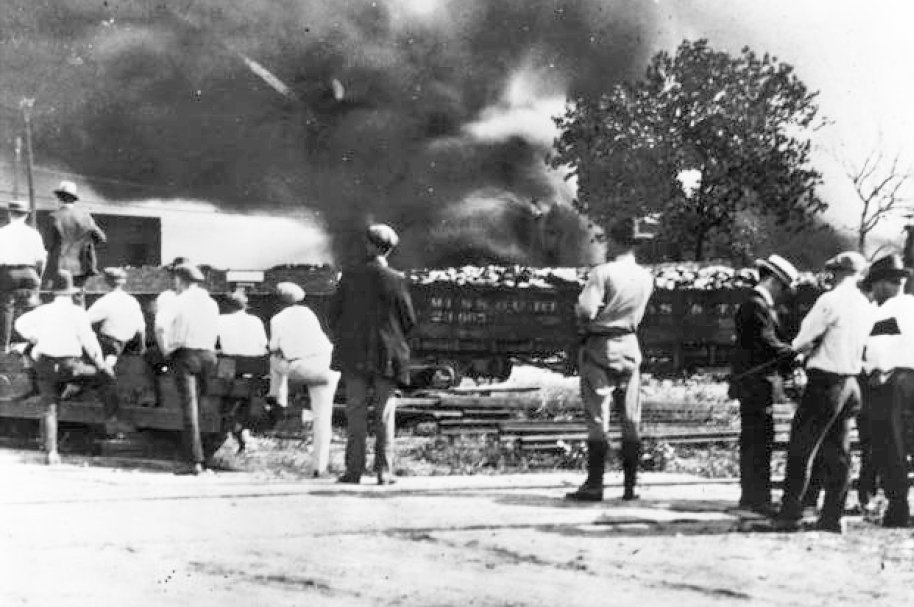
1921 Tulsa Race Massacre
During the 1921 Tulsa Race Massacre, which occurred for 16 - 18 hours from May 31 to June 1, 1921, a white mob attacked residents, homes and businesses in the predominantly Black Greenwood neighborhood of Tulsa, Oklahoma. The event remains one of the worst incidents of racial violence in U.S. history, and, for a period, remained one of the least-known: News reports were largely squelched, despite the fact that hundreds of people were killed and thousands left homeless.
On May 30, 1921, a 17-year-old Black teenager named Dick Rowland entered an elevator at the Drexel Building, an office building on South Main Street. At some point after that, a young white elevator operator, 17-year-old Sarah Page screamed; Rowland fled the scene. The police were called, and the next morning they arrested Rowland.
By that time, rumors of what supposedly happened on that elevator had circulated through the city’s white community. On the afternoon of May 30, 1921, a front-page story printed in the Tulsa Tribune ‘Nab Negro for Attacking Girl on an Elevator’, falsely accused Dick Rowland of sexually assaulting Sarah Page. It was this article that stoked the fires of racial tensions in the city.
As evening fell, rumors of a lynching spread throughout the community as an angry white gathered outside the courthouse, demanding the sheriff hand over Rowland. Sheriff Willard McCullough refused, and his men barricaded the top floor to protect the Black teenager.
Around 9 p.m., a group of about 25 armed Black men—including many World War I veterans—went to the courthouse to offer help guarding Rowland. After the sheriff turned them away, some of the white mob tried unsuccessfully to break into the National Guard armory nearby.
With rumors still flying of a possible lynching, a group of around 75 armed Black men returned to the courthouse shortly after 10 pm, where they were met by some 1,500 white men, some of whom also carried weapons.
Classroom Curriculum/Lesson Plan provided by Greenwood Rising
Homes and businesses burned in Greenwood
After shots were fired and chaos broke out, the outnumbered group of Black men retreated to Greenwood.
Over the next several hours, groups of white Tulsans—some of whom were deputized and given weapons by city officials—committed numerous acts of violence against Black people, including shooting an unarmed man in a movie theater.
The false belief that a large-scale insurrection among Black Tulsans was underway, including reinforcements from nearby towns and cities with large African American populations, fueled the growing hysteria.
As dawn broke on June 1, thousands of white citizens poured into the Greenwood District, looting and burning homes and businesses over an area of 35 city blocks. Firefighters who arrived to help put out fires later testified that rioters had threatened them with guns and forced them to leave.
According to a later Red Cross estimate, some 1,256 houses were burned; 215 others were looted but not torched. Two newspapers, a school, a library, a hospital, churches, hotels, stores and many other Black-owned businesses were among the buildings destroyed or damaged by fire.
By the time the National Guard arrived and Governor J. B. A. Robertson had declared martial law shortly before noon, the riot had effectively ended. Though guardsmen helped put out fires, they also imprisoned many Black Tulsans, and by June 2 some 6,000 people were under armed guard at the local fairgrounds.
In the hours after the Tulsa Race Massacre, all charges against Dick Rowland were dropped. The police concluded that Rowland had most likely stumbled into Page, or stepped on her foot. Kept safely under guard in the jail during the riot, he left Tulsa the next morning and reportedly never returned.
A 2001 Oklahoma State commission to study the Tulsa Race Riot researched the events and was able to confirm 100 - 300 deaths in the Greenwood Community, which nullified the June 1921 Tulsa Tribune article that declared only 36 deaths.
In the years to come, as Black Tulsans worked to rebuild their ruined homes and businesses, segregation in the city only increased, and Oklahoma’s newly established branch of the KKK grew in strength.
For decades, there were no public ceremonies, memorials for the dead or any efforts to commemorate the events of May 31-June 1, 1921. Instead, there was a deliberate effort to cover them up.
The Tulsa Tribune removed the front-page story of May 31 that sparked the chaos from its bound volumes, and scholars later discovered that police and state militia archives about the riot were missing as well. As a result, until recently the Tulsa Race Massacre was rarely mentioned in history books, taught in schools or even talked about.
Scholars began to delve deeper into the story of the riot in the 1970s, after its 50th anniversary had passed. In 1996, on the riot’s 75th anniversary, a service was held at the Mount Zion Baptist Church, which rioters had burned to the ground, and a memorial was placed in front of Greenwood Cultural Center.
For the entire story visit: https://www.history.com/topics/roaring-twenties/tulsa-race-massacre
*Source: The History Channel
Classroom Curriculum/Lesson Plan provided by Greenwood Rising


